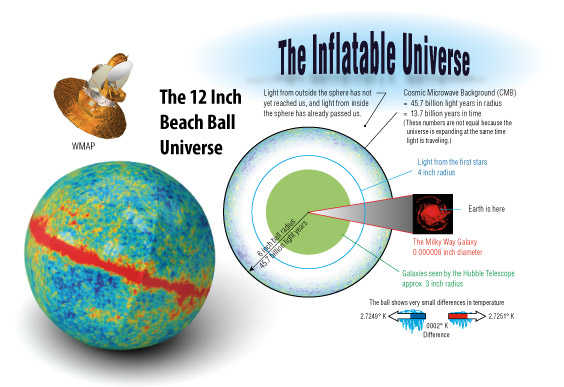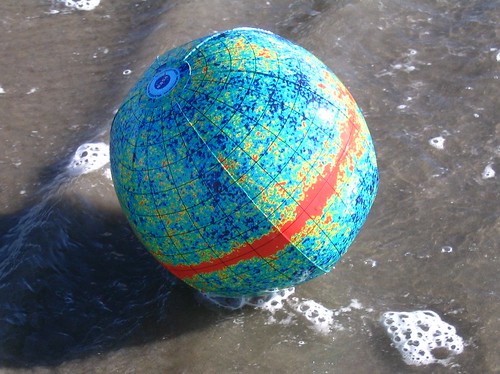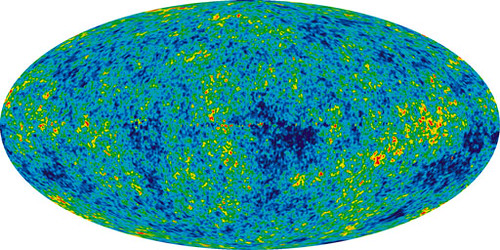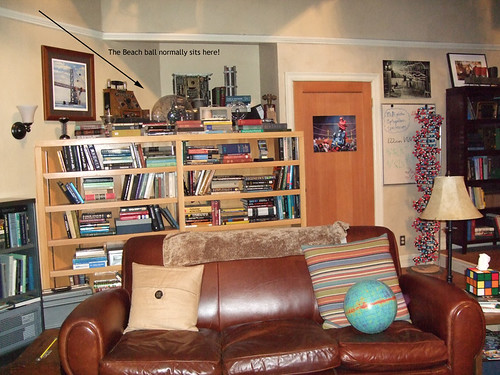The Universe on a Ball
- By Maggie Masetti
- September 24, 2010
- 8 Comments
[Sara’s note: This is the original blog entry that sparked the roadtrip – the interview about the as-seen-on-TV beach ball that got us onto the Warner Brothers studio lot. How many beach balls can do that? This is part 2 of our Blueshift roadtrip series. We’ll have the eagerly-anticipated Big Bang Theory set tour photos on Monday, in lieu of our weekly link round-up… and contests every day next week!]
Part of the fun of going to professional meetings is getting swag. You know what we mean – pens, USB drives, stress balls… once I even got some NASA hand sanitizer (true story!). I’ve also been on the other end of these convention giveaways. How do you choose something that has meaning? What if you want to go beyond a toy that someone will give to their kids or throw away in their hotel room – but that will actually have value? And furthermore, can you take something that seems like a giveaway toy, and turn it into a teaching tool?
Britt Griswold, who works on the Wilkinson Microwave Anisotropy Probe (WMAP), did just that. He took WMAP’s famous image of the early microwave universe and put it on a beach ball. Additionally, this beach ball can be seen in Leonard and Sheldon’s apartment on the hit TV show about NASA nerds much like us, The Big Bang Theory! We spoke to him about why and how in this exclusive interview.
Credit: NASA / WMAP Science Team
NASA Blueshift: What gave you the idea to try to represent the universe on a beach ball? Did the idea just come to you one day, or did you see that item in a promotional catalog and think, “A-ha!”?
Britt: The Cosmic Microwave Background image is made from microwave light that is almost as old as the universe. It was released 379,000 years after the beginning of our universe and is all around us, and can be seen in every direction. We are wrapped up in this giant baby picture from the beginning of time. So, how to show this to people in a non-scientific way, that allows them to “wrap the heads” around the idea?
The WMAP beach ball was the brain child of our Principle Investigator, Chuck Bennett. Chuck is the mission head honcho and a very savvy manger and scientist. Being an outstandingly successful PI means you are looking at all aspects of mission success, not just the science. Chuck looks at the science, engineering, money, political and educational aspects. This little thought of his has been an extremely successful visualization tool for classroom and publicity use. We have distributed close to 12,000 of the WMAP Universe teaching balls. Once the idea was hatched I went to work figuring out how it could be done.
NASA Blueshift: How is the universe represented on the beach ball? Human perspective has historically been that we’re in the center of everything looking outwards – though of course that’s not quite right, even if that’s the perspective we have by nature of where we’re making our observations from. How does that translate to the beach ball? Are we meant to be inside the beach ball at the center looking out?
Britt: We decided we wanted to show as detailed an image of the Comic Microwave Background (CMB) as possible. That means using the shortest of the microwaves we detect – these are captured by our “W” band microwave receivers (there are 5 bands on WMAP). It is true that we are at the center of everything we can survey, top of the heap, like Yertle the Turtle. But it is all relative, like Einstein said.
NASA Blueshift: How can one use this beach ball to teach about the universe?
Britt: The teaching ball is a relative product, it depends on where you are as to how it should be viewed. If you are outside on a clear night and you hold it up to the sky, you can theoretically make it match the view you see. The large red band around the middle is our Milky Way with a strong hot microwave signature. We are not interested in studying it, it is an obstacle we must overcome to see much deeper into space. But it is a good reference point for our audience. To make this work the image [on the ball] is printed as we see it on the sky, so it is technically backward or inside out for the other method of using the ball, which is as a scale model of the universe.
Imagine yourself at the center of this 12 inch ball looking in all directions. You will see the CMB image at the edge of the visible universe. What you are seeing is the first visible light in the universe. It has been stretched by the very fabric of space/time as the universe has expanded, so it now is microwave light, invisible to our eyes (but not WMAP’s telescopes!). The 12-inch beach ball represents about 93 billion light years of distance. How can that be when the universe is only 13.7 billion years old? Because it is expanding at the same time it is getting older. It is now expanding so fast that we will never see the light that a star on the far side of the ball is producing right this minute. We will only see the light from the past that was created in a much smaller universe.

The info sheet that comes with the beach ball
NASA Blueshift: Any thoughts on what is outside the beach ball if we are indeed at the center?
Britt: We can only see the light that has reached us since the beginning of the universe 13.7 billion years ago. That does not tell us anything about how big the universe really is. Well, almost nothing. What this light does tell us is that the geometry of space is almost perfectly “flat.” The geometry we learn in junior high school is valid on vast scales. That means potentially the universe goes on to infinite, or nearly infinite size, beyond what we can see. But it might not be perfectly flat, our measurements have room for small amounts of error, so the universe might have a boundary of some kind. But so, so, so, far away that we will never, ever, ever be able to be influenced by it, or detect it. We can only imagine it.
One really interesting thought is that our universe is shaped by the effects on many different forces that work at different scales. Nuclear forces hold atoms together, but gravity waves are so big and subtle that we are still searching for their signal from early in the universe. They originate even further back in time at the point of the inflation of the universe. What if there are other subtle forces that have effects over even larger scales? Could the physics of space/time be different trillions of light years away from our little visible patch of everything?
NASA Blueshift: Is it hard to wrap your head around the idea of taking the 3D universe, seeing it as a flat 2D image, and then making that image 3D again?
Britt: As an artist, it is not hard at all, anymore. Since I was a young boy I always had an interest in representing the 3D world on a 2D piece of paper. So I learned about perspective and projections. When computers came along, and 3D software was invented, it fascinated me as well. As an adult I have learned about placing 2D images back onto 3D shapes that can be viewed at any angle and turned back into new 2D images, so this was easy for me to wrap my head around. As soon a Chuck said “beach ball” I had the concept down.

From our exclusive Pacific Ocean photo shoot
NASA Blueshift: Was it hard to push this idea through NASA channels?
Britt: Each mission has money set aside for outreach, so getting the balls made was not a problem. The real difficulty was getting publication approval for a unflat (non-flat) printed item. The approval process at NASA was put in place to unify NASA’s public presence. But the design standards were created with flat printed paper in mind. The NASA logo must be in certain locations , text must be formatted just so. But what do you do with a printed object, meant to give to the public, that has data on all surfaces? We ultimately put the NASA logo on the South pole with label and URL text wrapped around the logo. Very non-standard for a non-standard product. Those folks at HQ must grind their teeth and roll their eyes when this sort of thing comes through the pipeline. But they have a very good graphic approval person in Debbie Rivera, who understands what can be done and produces good compromises.
NASA Blueshift: This beach ball has had some pop culture encounters – can you tell us about them?
Britt: Oh yes! The first time the Ball appeared in pop culture was in Alan Alda’s hands on a segment done for Scientific American Frontiers, one of my favorite shows. Most recently the Ball appears regularly on the shelf of the main apartment set for the very popular show about science nerds, The Big Bang Theory. This found its way on there from a science teacher married to one of the show’s writers, I think.
NASA Blueshift: Hopefully we can get John Mather to sign a few as giveaways (even though it’s not COBE data!)
Britt: That is a blast when he does that. The Nobel winner behind WMAP’s predecessor mission COBE approves of what we have done. I hope one day some of the scientist from WMAP will get their Nobel as well. They have managed to do an incredible thing by giving Cosmology a measurable yard stick to compare to future findings.
When Britt told us that the beach ball was on The Big Bang Theory, we wanted some pics of the beach ball on the set of for this article so you could see what to look for when you watch the show. (The beach ball usually lives on the book shelf behind the couch, next to the large clear celestial sphere.) We found a couple of screenshots, but we wanted something with a clear shot of the ball that we could use legitimately – so we asked Bill Prady on Twitter, and long story short, he invited us to come take our own picture. When we got there, the beach ball was sitting in “Sheldon’s spot” so we could get a good picture of it on set. We’re not sure how Sheldon would have felt about the WMAP beach ball getting the best view of the TV and the nice summer cross breeze!
Additionally, John Mather did indeed sign a few beach balls for us (he’s such a nice guy!) – and we brought a signed one to The Big Bang Theory set so they’d have an updated and autographed version!
Keep an eye on the blog and Twitter – we have cool prizes coming all next week, and you’ll want to know how to enter! Thanks to Britt for his time – and thanks to the show’s co-creator Bill Prady and his fantastic assistant Tara Hernandez!






Not one single comment yet? This story was the best one I’ve read all day.
Keep up the good work.
Best regards, a fan (of both NASA and TBBT )
Thanks! :D
This is a really cool story. I would love to have one of those beach balls!
Good story! I’ll see how can I find some of those WMAP beach balls here in Argentina!! I’ts a good item to show off!! =D
Very nice article and the beachball is a great idea. So much of what NASA does is not flat but spherical and other shapes too (the recent EPOXI asteroid flyby. Yet finding 3d representations is nearly impossible. I’d like to see every classroom with one of your universe representations and a scale inflatable earth, moon and Mars; maybe the solar system.
“Funny” Microwave Background
“We decided we wanted to show as detailed an image of the Comic Microwave Background (CMB) as possible.”
Great story, thanks!
[…] it’s been featured in shows like, appropriately, The Big Bang Theory. There’s even an interview with the ball’s creator on the Goddard […]